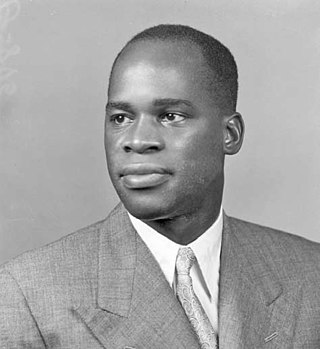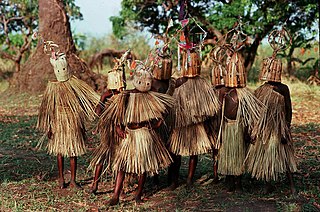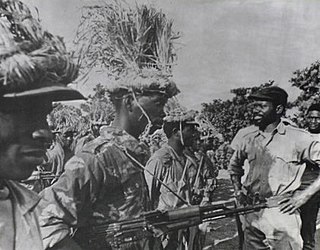
Mozambique, officially the Republic of Mozambique, is a country located in southeastern Africa bordered by the Indian Ocean to the east, Tanzania to the north, Malawi and Zambia to the northwest, Zimbabwe to the west, and Eswatini and South Africa to the southwest. The sovereign state is separated from the Comoros, Mayotte and Madagascar by the Mozambique Channel to the east. The capital and largest city is Maputo.

Tanzania comprises many lakes, national parks, and Africa's highest point, Mount Kilimanjaro. Northeast Tanzania is mountainous, while the central area is part of a large plateau covered in grasslands. The country also contains the southern portion of Lake Victoria on its northern border with Uganda and Kenya.

Samora Moisés Machel was a Mozambican military commander and political leader. A socialist in the tradition of Marxism–Leninism, he served as the first President of Mozambique from the country's independence in 1975.

Cabo Delgado is the northernmost province of Mozambique. It has an area of 82,625 km2 (31,902 sq mi) and a population of 2,320,261 (2017). As well as bordering Mtwara Region in the neighboring country of Tanzania, it borders the provinces of Nampula and Niassa. The region is an ethnic stronghold of the Makonde tribe, with the Makua and Mwani as leading ethnic minorities.

Eduardo Chivambo Mondlane was the President of the Mozambican Liberation Front (FRELIMO) from 1962, the year that FRELIMO was founded in Tanzania, until his assassination in 1969. Born in Mozambique, he was an anthropologist by profession, and worked as a history and sociology professor at Syracuse University before returning to Mozambique in 1963.
The Makonde are an ethnic group in southeast Tanzania, northern Mozambique, and Kenya. The Makonde developed their culture on the Mueda Plateau in Mozambique. At present they live throughout Tanzania and Mozambique, and have a small presence in Kenya. The Makonde population in Tanzania was estimated in 2001 to be 1,140,000, and the 1997 census in Mozambique put the Makonde population in that country at 233,358, for an estimated total of 1,373,358. The ethnic group is roughly divided by the Ruvuma River; members of the group in Tanzania are referred to as the Makonde, and those in Mozambique as the Maconde. The two groups have developed separate languages over time but share a common origin and culture.

Ruvuma River, formerly also known as the Rovuma River, is a river in the African Great Lakes region. During the greater part of its course, it forms the border between Tanzania and Mozambique. The river is 800 kilometres (500 mi) long, with a drainage basin of 155,500 square kilometres (60,000 sq mi) in size. Its mean annual discharge is 475 m3/s (16,800 cu ft/s) at its mouth.

The Yao people are a major Bantu ethnic and linguistic group based at the southern end of Lake Malawi. They played an important role in the history of Southeast Africa, notably in the 19th century. The Yao are a predominantly Muslim-faith group of about two million, whose homelands encompass the countries of Malawi, the north of Mozambique, and the Ruvuma and Mtwara Regions of Tanzania. The Yao have a strong cultural identity, transcending national borders.

Palma is a town on the northeast coast of Mozambique's Cabo Delgado Province. Less than 32 kilometres (20 mi) away is the border with Mtwara Region of Tanzania to the north and north-west.

The Mozambican War of Independence was an armed conflict between the guerrilla forces of the Mozambique Liberation Front or FRELIMO and Portugal. The war officially started on September 25, 1964, and ended with a ceasefire on September 8, 1974, resulting in a negotiated independence in 1975.
Yao is a Bantu language in Africa with approximately two million speakers in Malawi, and half a million each in Tanzania and Mozambique. There are also some speakers in Zambia. In Malawi, the main dialect is Mangochi, mostly spoken around Lake Malawi. In Mozambique, the main dialects are Makale and Massaninga. The language has also gone by several other names in English, including chiYao or ciYao, Achawa, Adsawa, Adsoa, Ajawa, Ayawa, Ayo, Ayao, Djao, Haiao, Hiao, Hyao, Jao, Veiao, and waJao.

The following outline is provided as an overview of and topical guide to Mozambique:
The Sabaki languages are the Bantu languages of the Swahili Coast, named for the Sabaki River. Sabaki is a Pokomo word for Large Fish. In addition to Swahili, Sabaki languages include Ilwana (Malakote) and Pokomo on the Tana River in Kenya, Mijikenda, spoken on the Kenyan coast; Comorian, in the Comoro Islands; and Mwani, spoken in northern Mozambique. In Guthrie's geographic classification, Swahili is in Bantu zone G, whereas the other Sabaki languages are in zone E70, commonly under the name Nyika.
The Nyasa are a people of southeastern Africa, concentrated mainly in Malawi, southwestern Tanzania and parts of northern Mozambique. The people are also known as the Kimanda, Kinyasa and Manda. Significant populations of Nyasa live along the shores of northeastern Lake Malawi. Many Nyanja people of Malawi refers to themselves as Nyasa; as of 2010 roughly 500,000 claim to be Nyasa people.

The Mtwara Development Project is a major infrastructure development project involving southern Tanzania, northern Mozambique, eastern Malawi and Eastern Zambia. The goal of this project is to provide road, rail and waterway access from the surrounding region to the Port of Mtwara. The region and the corridor has been neglected by the respective governments for over 40 years and the recent discovery of oil, gas and various minerals has kick started the development of the project. A road and rail link is to be built from the port of Mtwara to Mbamba Bay on Lake Nyasa to link Malawi to the corridor and further road links into Mozambique will facilitate access to northern Mozambique.

Tanzania–Mozambique relations are bilateral relations between Tanzania and Mozambique.

At least 30 tropical cyclones have affected the Southern African mainland. Three southeastern African countries border the Indian Ocean – Tanzania, Mozambique, and South Africa. Other inland countries also experience the effects of tropical cyclones, including Botswana, Eswatini, Lesotho, Malawi, Namibia, Zambia, and Zimbabwe.
The East African coral coast is a marine ecoregion along the eastern coast of Africa. It extends along the coasts of Kenya, Tanzania, and northern Mozambique, from Lamu in Kenya to Angoche in Mozambique. It adjoins the Northern Monsoon Current Coast ecoregion to the north, and the Bight of Sofala/Swamp Coast ecoregion to the south.

The Battle of Palma or the Battle for Palma was fought during late March and early April 2021 over control of the city of Palma in Mozambique, between the Mozambique Defence Armed Forces, other Mozambican security forces and private military contractors on one side, and Islamist rebels reportedly associated with the Islamic State (IS) on another side. The Islamists invaded the city, killing dozens of people before Mozambique regained control days later. Palma was left destroyed, and a major oil and gas company decided to suspend all operations in the area due to the battle. Researchers have described the battle as an overall success for the insurgents. The rebels also maintained their presence in the town's surroundings, and continued to raid Palma in the following weeks. The battle was part of the insurgency in Cabo Delgado, which started in 2017 and has resulted in the deaths of thousands of people, mainly local civilians.

The Mwani people are a Bantu ethnic group primarily inhabiting the coastline of the Cabo Delagado Province of Mozambique. The Mwani people speak the Kimwani language, also known as the Ibo language, which is a Bantu language belonging to the Niger-Congo language family. They are often considered part of the Swahili cultural world as they have important connections with the East African coast













